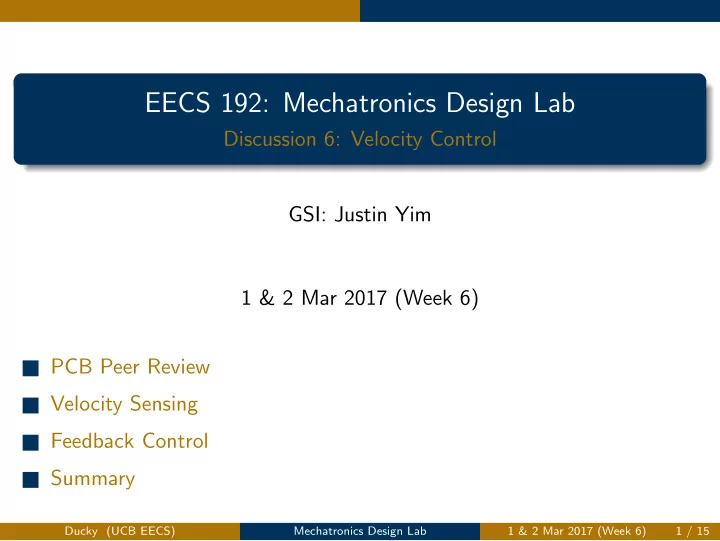

EECS 192: Mechatronics Design Lab Discussion 6: Velocity Control GSI: Justin Yim 1 & 2 Mar 2017 (Week 6) 1 PCB Peer Review 2 Velocity Sensing 3 Feedback Control 4 Summary Ducky (UCB EECS) Mechatronics Design Lab 1 & 2 Mar 2017 (Week 6) 1 / 15
PCB Peer Review PCB Peer Review Ducky (UCB EECS) Mechatronics Design Lab 1 & 2 Mar 2017 (Week 6) 2 / 15
PCB Peer Review Activity PCB Peer Review ◮ Why peer review? ◮ Get a fresh perspective on your board to catch bugs you’ve missed ◮ Get a new opinion from someone with a different background ◮ Facilitate transfer of knowledge ◮ Things to look for in your peer reviews: ◮ Schematic style: messiness hides bugs! Hopefully a fairly ◮ Circuit safety and spec check readable schematic ◮ Layout sanity: DRC violations, don’t design for minimums ◮ Really, anything that looks off Ducky (UCB EECS) Mechatronics Design Lab 1 & 2 Mar 2017 (Week 6) 3 / 15
PCB Peer Review Activity PCB Peer Review Pair up with another team (or another two teams, if teams don’t line up) Bring up the PCB Peer Review Checklist ( www-inst.eecs.berkeley.edu/~ee192/sp15/docs/dis5-pcbchecklist.pdf ) but feel free to add additional criteria as you want You’ll have 30 minutes to review each other’s boards (so about 15 minutes per team in a group) Note anything you really liked about the boards you reviewed as well as pitfalls others should know and avoid We’ll discuss as a class after you’re done in groups Ducky (UCB EECS) Mechatronics Design Lab 1 & 2 Mar 2017 (Week 6) 4 / 15
Velocity Sensing Velocity Sensing Ducky (UCB EECS) Mechatronics Design Lab 1 & 2 Mar 2017 (Week 6) 5 / 15
Velocity Sensing Basics Brainstorm! What are some ways to sense velocity? pros and cons of your methods? Ducky (UCB EECS) Mechatronics Design Lab 1 & 2 Mar 2017 (Week 6) 6 / 15
Velocity Sensing Simple Encoder Optical Encoders Optical encoders... ◮ Detects when sensor is lit up ◮ Reflective sensor: light up codewheel, sensor detects reflection ◮ Photointerruptors: direct light beam from transmittor to detector, interrupt by object ◮ Outputs a pulse train Sharp GP2S60 ... ◮ Compact reflective sensor including emitter and detector ◮ Open collector output ◮ Optimal distance 0.7mm GP2S60 reflective sensor Ducky (UCB EECS) Mechatronics Design Lab 1 & 2 Mar 2017 (Week 6) 7 / 15
Velocity Sensing Simple Encoder Software Techniques Two simple ways to measure speed: Pulse width measurement ◮ Measure width between transitions Pulse counting ◮ Count number of transitions in timespan Ducky (UCB EECS) Mechatronics Design Lab 1 & 2 Mar 2017 (Week 6) 8 / 15
Velocity Sensing Simple Encoder Beaglebone Blue The Beaglebone Blue has a real-time module dedicated to reading quadrature encoders Ducky (UCB EECS) Mechatronics Design Lab 1 & 2 Mar 2017 (Week 6) 9 / 15
Velocity Sensing Simple Encoder Quadrature Encoder ◮ Two square wave signals phase shifted by 90 degrees ◮ Generated by two sensors at an offset ◮ Can distinguish forwards from backwards ◮ More robust to spurious spikes Two GP2S60 sensors Ducky (UCB EECS) Mechatronics Design Lab 1 & 2 Mar 2017 (Week 6) 10 / 15
Velocity Sensing Simple Encoder Quadrature Hack ◮ Beaglebone Blue only accepts quadrature inputs ◮ If your car only goes forwards, we can “fake” one signal ◮ Delay the signal with an RC circuit and pass it through a comparator Quadrature hack Ducky (UCB EECS) Mechatronics Design Lab 1 & 2 Mar 2017 (Week 6) 11 / 15
Velocity Sensing Simple Encoder Live Demo! Low speed demo High speed demo what waveforms should you expect to see? Issues skipped pulses, inconsistent pulse lengths Ducky (UCB EECS) Mechatronics Design Lab 1 & 2 Mar 2017 (Week 6) 12 / 15
Feedback Control Feedback Control Ducky (UCB EECS) Mechatronics Design Lab 1 & 2 Mar 2017 (Week 6) 13 / 15
Feedback Control PID control PID ◮ Control is the sum of three components: PWM = P + I + D ◮ Proportional Control ◮ P = K p ∗ ( difference between sensor input and data ) ◮ Very intuitive- increasing effort for increasing error. ◮ Integral Control ◮ I = K i ∗ ( integration of error over time) ◮ Overcomes offset errors (example: friction) ◮ Derivative Control ◮ D = K d ∗ ( instantaneous derivative of the error) ◮ Helps prevent oscillation (example: steering) ◮ Video about PID control on vehicle ◮ https://www.youtube.com/watch?v=4Y7zG48uHRo ◮ Video courtesy of MIT Aerospace Controls Lab Ducky (UCB EECS) Mechatronics Design Lab 1 & 2 Mar 2017 (Week 6) 14 / 15
Summary Summary ◮ Optical Encoders ◮ PID control overview Ducky (UCB EECS) Mechatronics Design Lab 1 & 2 Mar 2017 (Week 6) 15 / 15
Recommend
More recommend